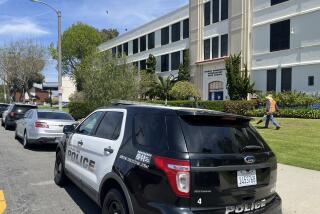Violence in Schools on Rise Across U.S., Report Finds : Education: National survey says few campuses are immune to crime. To many, concern about the issue is as important as academics.
WASHINGTON — Violence now rivals academics as the top concern of the nation’s public schools, with shootings, stabbings and other serious assaults increasing in number and spreading from urban districts to suburbs and small towns, the National League of Cities reported Tuesday.
More than 80% of 700 communities surveyed by the league said that violence is a serious problem in classrooms, hallways and playgrounds and nearly 40% reported that the problem has increased noticeably over the past five years.
Department of Education officials said they realized nearly two years ago that violence and the fear of violence had become such a huge issue that the federal government would have to help schools create safe environments as a prerequisite to academic reform.
“The protective aura around schools has been shattered,” Deputy Secretary of Education Madeleine M. Kunin said in an interview. “It’s a big concern for parents and students. Children really can’t learn well in an environment where there’s fear and intimidation or even the suspicion of violence.” Suburban and rural communities, she added “are not immune” from school violence.
While school violence is particularly prevalent in large cities, 30% of suburban and rural districts said they have experienced significant increases.
The problem is so pervasive, the report’s authors said, that concern about violence has become “as prominent an issue as academic performance or curriculum choices in many schools.”
One-fourth of all the schools participating in the survey reported that in the previous year students had died or suffered injuries requiring hospitalization as a result of violence. The percentage was even higher for big-city schools, with 41% of them reporting deaths or serious injuries.
To fight back, police forces are beefing up patrols of schools and nearly 20% of surveyed communities now use metal detectors regularly to keep weapons out of schools.
Youth gangs have become almost as ubiquitous as violence itself in schools.
In both medium and large cities, gangs were blamed for having a “serious influence” on violence in classrooms, playgrounds and hallways. But the impact of gangs was not restricted to large urban centers. Forty percent of the suburban communities and non-metropolitan towns and cities said gangs were a factor in violence in their schools as well.
The survey showed that violent behavior learned on the street is not abandoned when youngsters cross their schools’ thresholds, according to Randy Arndt, a spokesman for the league. The violence creeping into school campuses reflects the general rise in youth crime.
The survey was released just two weeks after the Centers for Disease Control and Prevention reported that the homicide rate among young men 15 to 19 nearly tripled between 1985 and 1991, surpassing the rates for men older than 25. That increase was attributed to recruitment of teens into drug markets and the gangs that run them and a more frequent use of guns to settle disputes.
Indicating the political resonance of the issue campus violence, President Clinton signed last month an order that would withhold federal funds from school districts that fail to expel students who bring guns to school.
The $13 billion education bill also provides new monies to help schools deal with violence.
Even in the vast majority of schools, where there have been no serious incidents of violence, Kunin said, “the potential is there” for violence.
The best remedies are crafted mutually by parents, teachers and administrators who work together to foster discipline in schools and teach children nonviolent ways to resolve conflicts, she said.
More to Read
Sign up for Essential California
The most important California stories and recommendations in your inbox every morning.
You may occasionally receive promotional content from the Los Angeles Times.










